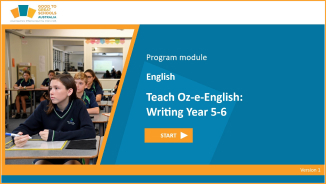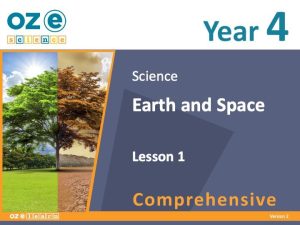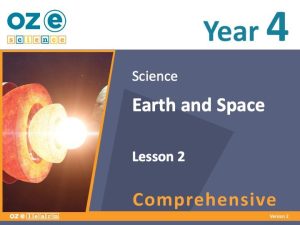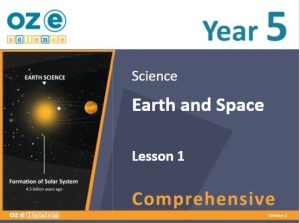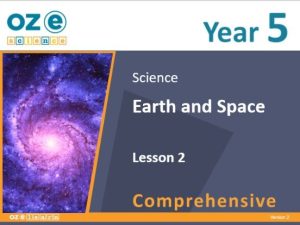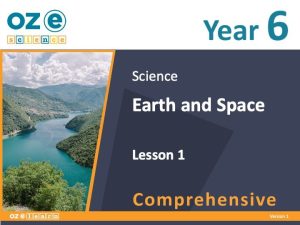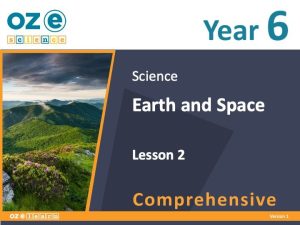Oz-e-science
Earth and Space Comprehensive Years F–6
Oz-e-science Earth and Space Comprehensive Year units align to the Australian Curriculum Content Descriptions
Free Starter Lessons
Year Overview
Year 4
Australian Curriculum Content Descriptions
Overview
Earth and Space Comprehensive: Year 4 is an Earth and Space Sciences program for Year 4 students. It aligns to the Australian Curriculum Science Understanding:
- Earth’s surface changes over time and as a result of natural processes and human activity (ACSSU075).
Note: This curriculum program is currently being updated to align with the Australian Curriculum 9.0. Updated versions will be released in early 2024.
Learning Objectives
In Lessons 1 to 14, students learn about:
- how the Earth was formed
- identifying the four main layers of Earth
- the Earth’s main tectonic plates
- continental drift theory
- landforms and how they are formed
- the three main types of rock
- the five main layers of soil
- how fossil fuels were formed and their uses
- the reasons why soil erodes and degrades
- the effects of climate change on the Earth
- conducting research at a local geological site in preparation for the field trip
- how to conduct field research at a local geological site and record findings
- writing a report using findings from reading and field research
- practising presenting the information report to an audience.
Success Criteria
- Identify the two main processes that formed the Earth.
- Explain why humans are able to live on Earth.
- Identify and label the Earth’s four main layers.
- Identify what tectonic plates are.
- Describe two examples of what happens where tectonic plates meet.
- Outline the tectonic plate boundaries.
- Explain what continental drift theory is.
- Represent Pangea in an online puzzle.
- Describe the difference between constructive and destructive forces.
- Classify landforms created by constructive and destructive forces.
- Classify landforms created by constructive and/or destructive processes in a card game.
- Describe the three main types of rocks and how they were formed.
- Classify rocks in the rock cycle.
- Describe the five main layers of soil.
- Represent the layers of soil in a labelled artwork.
- Describe the three main types of fossil fuels.
- Plot to represent the main fossil fuel reserves on a map of Australia.
- Identify the reasons soil erodes and degrades.
- Sequence a cause-and-effect chart.
- Identify the effects of climate change on the Earth.
- Represent and create a carbon footprint artwork.
- Complete research and take notes about a local geological site visited on a field trip.
- Learn how to conduct field research conducted at a local geological site and record findings.
- Create an information report using reading research and field research from the local geological site.
- Practise presenting information report to an audience.
Assessment
Progress Tests
Progress tests are conducted after every second lesson, allowing teachers to monitor student understanding of the concepts taught over the past two lessons and to identify where reteaching is needed. The Teaching Guide contains the testing questions, and the Student Workbook has a section where students write their answers and score themselves.
Structured Research Activity
The Structured Research Activity (SRA) for this unit is: Students conduct research at a local geological site and record, report and present findings. The SRA takes place over two lessons so students can apply the Science Understanding and Science Inquiry Skills covered in the unit. Teachers use the Guide to Making Judgements, which is included in the Teaching Guide, to mark the SRA.
End-of-Unit Assessment
The last lesson is the end-of-unit assessment, which has a variety of question formats (e.g. label the diagram, circle the correct answer) to assess student mastery of content from the unit. The end-of-unit assessment is in the Teaching Guide. Teachers copy the assessment and distribute to students at testing time.
Explicit Instruction for Science
Oz-e-science uses a teaching approach and curriculum that uses explicit teaching of content knowledge of science and explicit teaching and practical scientific inquiry using the Scientific Method. Read more about pedagogy here.
Year 5
Australian Curriculum Content Descriptions
Overview
Earth and Space Comprehensive 5 is an Earth and Space Sciences program for Year 5 students. It aligns to the Australian Curriculum Science Understanding:
- The Earth is part of a system of planets orbiting around a star (the Sun) (ACSSU078).
Note: This curriculum program is currently being updated to align with the Australian Curriculum 9.0, updated versions will be released in early 2024.
Learning Objectives
In Lessons 1 to 15, students learn about:
- what stars are
- galaxies
- what solar systems are
- the four rocky planets in our solar system
- the four gas planets in our solar system
- the five dwarf planets in our solar system
- the moons in our solar system
- other space rocks in our solar system
- how telescopes work
- the Scientific Method in space science and build their own telescope
- spacecrafts and explaining their purpose
- satellites and plan to build their own model satellite
- building their satellite and preparing a presentation
- presenting and explaining their satellite.
Success Criteria
- Explain that stars are massive balls of burning gas.
- Describe at least two different stars in our universe.
- Represent some of our star constellations.
- Explain how distances in space are measured.
- Explain what galaxies are.
- Describe the shapes of different galaxies in our universe.
- Represent the shape of a galaxy.
- Explain what a solar system is.
- Describe three objects in our solar system.
- Represent our own solar system as a rap song.
- Describe the four rocky planet planets in our solar system.
- Explain where these rocky planets are found.
- Represent the rocky planets in a booklet.
- Describe the four gas planets in our solar system.
- Explain where these gas planets are found.
- Represent the gas planets in a booklet.
- Describe the five dwarf planets.
- Compare dwarf planets and planets.
- Represent all the planets and dwarf planets to scale.
- Explain what moons are.
- Describe at least two moons in our solar system.
- Compare the moons of Neptune.
- Describe three different types of space rocks in our solar system.
- Compare asteroids, meteors and comets.
- Explain how a telescope works.
- Describe at least one space telescope.
- Compare direct and indirect evidence.
- Identify three important steps for planning a space investigation.
- Plan an investigation.
- Build their own telescope.
- Classify different types of spacecrafts.
- Describe at least three different spacecraft.
- Explain the purpose and mission of these spacecraft.
- Identify the parts of a satellite.
- Explain what the parts of a satellite are for.
- Research a chosen satellite.
- Build a satellite and label its parts.
- Plan a presentation.
- Evaluate an investigation.
- Explain their satellite and its parts.
- Communicate the investigation.
Assessment
Progress Tests
Progress tests are conducted after every second lesson, allowing teachers to monitor student understanding of the concepts taught over the past two lessons and to identify where reteaching is needed. The Teaching Guide contains the testing questions, and the Student Workbook has a section where students write their answers and score themselves.
Structured Research Activity
The Structured Research Activity (SRA) for this unit is: Students build a model satellite and explain their model in a presentation. The SRA takes place over two lessons so students can apply the Science Understanding and Science Inquiry Skills covered in the unit. Teachers use the Guide to Making Judgements, which is included in the Teaching Guide, to mark the SRA.
End-of-Unit Assessment
The last lesson is the end-of-unit assessment, which has a variety of question formats (e.g. label the diagram, circle the correct answer) to assess student mastery of content from the unit. The end-of-unit assessment is in the Teaching Guide. Teachers copy the assessment and distribute to students at testing time.
Explicit Instruction for Science
Oz-e-science uses a teaching approach and curriculum that uses explicit teaching of content knowledge of science and explicit teaching and practical scientific inquiry using the Scientific Method. Read more about pedagogy here.
Year 6
Australian Curriculum Content Descriptions
Overview
Earth and Space Comprehensive: Year 6 is an Earth and Space Sciences curriculum program for Year 6 students. It aligns to the Australian Curriculum Science Understanding:
- Sudden geological changes and extreme weather events can affect Earth’s surface (ACSSU096).
Note: This curriculum program is currently being updated to align with the Australian Curriculum 9.0. Updated versions will be released in early 2024.
Learning Objectives
In Lessons 1 to 15, students learn about:
- tectonic plates and their role in changing the Earth’s surface
- how mountain ranges and trenches are formed
- the formation of volcanoes
- the different types of volcanoes
- earthquakes and where they occur
- tsunamis and how they affect the Earth’s surface
- how to predict and track volcanic
- activities that have affected the Earth’s surface
- examples and causes of extreme weather events and their effects on the Earth’s surface
- cyclones and how they affect the Earth’s surface
- floods and how they affect the Earth’s surface
- bushfires and how they affect the Earth’s surface
- droughts and how they affect the Earth’s surface
- how extreme weather affects humans
- conducting research and creating a presentation to share findings
- communicating the findings from their investigation.
Success Criteria
- Describe Earth’s tectonic plates.
- Explain what happens at plate boundaries.
- Identify a plate boundary as convergent, divergent or transform.
- Describe how mountain ranges form at convergent plate boundaries.
- Explain how tranches form at oceanic plate boundaries.
- Explain how volcanoes form.
- Describe the basic structure of a volcano.
- Explain how volcanoes affect the earth’s surface.
- Observe how viscosity of a volcano’s lava affects its shape.
- Classify the different types of volcanoes.
- Identify signs that a volcano is about to erupt.
- Explain how volcanoes affect the Earth’s surface.
- Analyse data to determine volcanic activity.
- Describe how earthquakes form.
- Explain how earthquakes affect the Earth’s surface.
- Sequence the progression of an earthquake.
- Describe how tsunamis form.
- Explain how tsunamis affect the Earth’s surface.
- Represent how different natural events result in tsunamis.
- Predict the activity of a chosen volcano.
- Record information on a chosen volcano.
- Identify where weather activities occur in the atmosphere.
- Explain what extreme weather conditions means.
- Classify extreme weather conditions.
- Explain how tropical cyclones are formed.
- Describe the formation of a tropical cyclone.
- Classify different types of tropical cyclones.
- Describe the different types of floods that occur.
- Explain how floods affect the Earth’s surface.
- Research how rainfall might affect floods in the local community.
- Describe how Australian trees affect bushfires.
- Explain how climate change affects the intensity of bushfires.
- Report on plant life after bushfires.
- Describe how droughts occur.
- Explain how droughts affect the Earth’s surface.
- Predict how droughts can affect animals in the community.
- Explain how extreme weather affects humans.
- Identify ways to play a part.
- Research information on a chosen volcano.
- Record findings about the chosen volcano.
- Plan a presentation.
- Communicate the findings of the presentation.
Assessment
Progress Tests
Progress tests are conducted after every second lesson, allowing teachers to monitor student understanding of the concepts taught over the past two lessons and to identify where reteaching is needed. The Teaching Guide contains the testing questions, and the Student Workbook has a section where students write their answers and score themselves.
Structured Research Activity
The Structured Research Activity (SRA) for this unit is: Students investigate volcano formation and present their findings to the class. The SRA takes place over two lessons so students can apply the Science Understanding and Science Inquiry Skills covered in the unit. Teachers use the Guide to Making Judgements, which is included in the Teaching Guide, to mark the SRA.
End-of-Unit Assessment
The last lesson is the end-of-unit assessment, which has a variety of question formats (e.g. label the diagram, circle the correct answer) to assess student mastery of content from the unit. The end-of-unit assessment is in the Teaching Guide. Teachers copy the assessment and distribute to students at testing time.
Explicit Instruction for Science
Oz-e-science uses a teaching approach and curriculum that uses explicit teaching of content knowledge of science and explicit teaching and practical scientific inquiry using the Scientific Method. Read more about pedagogy here.
Other Units
Lesson Design
Lesson Objective
Success Criteria
Activating Prior Knowledge
I Do
We Do
Apple Question
You Do
Revise
Professional Learning
